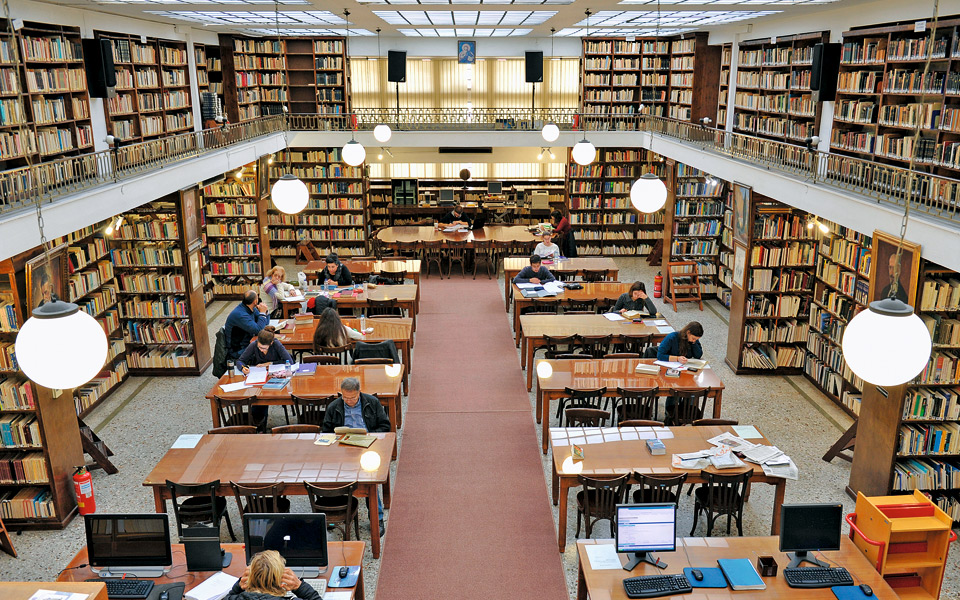UNIVERSITY CAMPUS
Covering 250 hectares with 100 buildings, 5 schools, 24 departments, 30,000 students, 750 teaching staff and 290 administrative staff, Patras University is a city within a city. Many parts of the infrastructure were, and still are, ahead of their time. It had its own biological treatment system long before the rest of the city and boasts a world-class conference center, as well as perhaps the best organized university library in the country. It even has an animal shelter on a 4,000 m2 site (http://smz.upatras.gr), while central points around the campus are adorned with dozens of sculptures, created by artists from all over Greece.
ACHAIA CLAUSS
The winery founded in 1861 by Bavarian Gustav Clauss, a currant merchant, still stands proudly in the foothills of the Panachaiko mountain range, creating a lasting impression on visitors. Stone buildings in lush green surroundings, an amazing view of Patras from an altitude of 500 meters, wood-carved barrels (real works of art) and Mavrodaphne, the name given by Clauss himself to the celebrated sweet wine of Patras, inspired by the black eyes of his beautiful fiancée, Daphne, who sadly died at a young age. (www.clauss.gr)

© Vangelis Zavos
ARCHAEOLOGICAL MUSEUM
The architecturally impressive building designed by Theofanis Bobotis at the north entrance to the city, with 3,000 m2 of exhibition space, houses the history of Patras from the Bronze Age to the Late Roman period, i.e. from 3000 BC to the 4th century AD. Among the thousands of exhibits, highlights include exquisite mosaics that once decorated the floors of luxurious city residences dating to Roman times. (www.patrasmuseum.gr)

© Vangelis Zavos
GEORGIOU I SQUARE
Its name has changed many times: Dimokratias, Kentriki, Thomopoulou, Ethniki, Paliggenesias, Kalamogdarti and Othonos. This was where, in 1843, modern Greece’s first constitution was read out. The present name has become established since 1863. Since 1875, two attractive fountains have adorned the square, which cost the then exorbitant amount of 70,000 drachmas. The square remains the central point of city life, as envisaged by Kapodistrias, a venue for many events, including of course the Carnival.
ROMAN ODEON
Located in the Upper City, it was built around AD 161, slightly earlier than the Odeon of Herodes Atticus in Athens. It stopped being used in the late 3rd century after a devastating fire, which may be linked to the invasion of the Heruli. Its reconstruction was completed in 1956, when it was restored to its original form. With a seating capacity of 2,200, it serves as the main venue for the Patras International Festival.

© Vangelis Zavos
CHURCH OF ST. ANDREW
Symbol of Orthodoxy and place of pilgrimage for Christians from all over the world. The main dome, with a height of 46 meters, is visible from almost everywhere in the city. The interior, adorned with unique icon paintings, houses relics of Andrew the Apostle, the city’s patron saint, and portions of the cross on which he was martyred.

© Vangelis Zavos
APOLLON THEATER
Galleries with gold balustrades, rows of velvet seats and an exquisitely painted ceiling, this micrograph of La Scala in Milan was designed by the German architect Ernst Ziller in the neoclassical style. Construction began in 1871 and was completed the following year. The cost of construction – 148,542 drachmas – was paid for mainly by the city’s multi-ethnic merchant community. The Apollon’s first performance was Verdi’s Un ballo in maschera, by an Italian company on 10 October, 1872.
MUNICIPAL LIBRARY
The library was founded in 1908 around an initial core of 5,000 volumes donated by the Craft Association of Patras. Today, its collection includes some very rare publications, including Stephanus’ Thesaurus Linguae Graecae, published in 1572 and Archimedes opera quae extant, published in 1615. The splendid building is located at 110 Maizonos St. The ground floor houses the Municipal Gallery. (www.patraslibrary.weebly.com).

© Vangelis Zavos
PSILA ALONIA
Psila Alonia – called Psilalonia by locals – is perhaps the most beautiful square in Patras. From the Roman period up until modern times, it was the neighborhood of the city’s most affluent families, as attested by the foundations of luxurious Roman residences and a number of splendid neoclassical buildings. In an elevated, balcony-like position, which affords a wonderful view as far as the sea, the square is a great place for a leisurely stroll, especially in early evening, when you can watch the sun set behind the distant mountains of Aitoloakarnania.

© Studio Stigmiotypo
PALAMAS RESIDENCE
This two-story neoclassical, stone house at 241 Korinthou St. is where Kostis Palamas was born in 1859. The house was sold just a few months ago by the heirs of Greece’s national poet, who live in Switzerland. It was bought by 75-year-old Greek-American businessman Thanasis Stefanopoulos, who reportedly intends to make the building available to the Association of Patras Artists, so it can be used as a museum dedicated to Olympism, Arts and Letters. We shall see…











